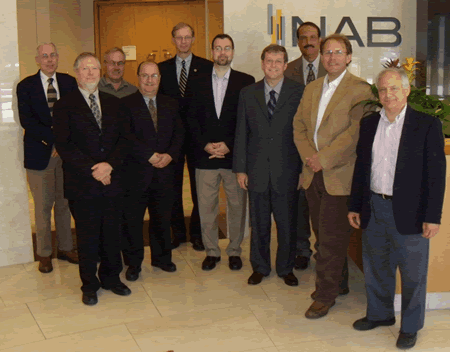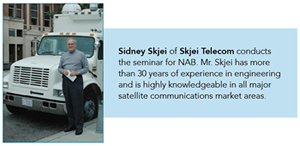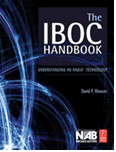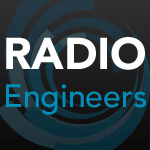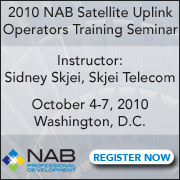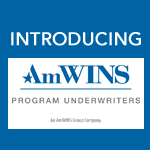
|
Method
to Improve FM Stereo to be Discussed at NRSC Meeting 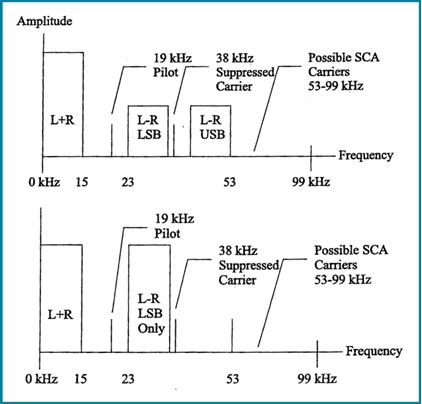
Frank's presentation will be based on a White Paper that he submitted to the NRSC in June of this year entitled "Method to Improve Conventional FM-Stereo Transmission Performance, Reduce Multipath, and Provide Increased Protection to the Baseband Spectrum." In his paper he discusses a method utilizing single sideband suppressed carrier (SSB-SC) modulation of the stereophonic subcarrier in the FM multiplex baseband that he believes is compatible with existing radio receivers. Frank notes that this is not an entirely new proposal and references a technical paper from the 1997 NAB Broadcast Engineering Conference (BEC) by William H. Gillman entitled "A New Method of Generating FM and Television Stereo Composite Baseband Yields Improved Broadcast Performance." The illustration at right, taken from the 1997 BEC paper, illustrates the concept being proposed. The upper spectrum in this figure depicts a conventional baseband FM stereo spectrum, showing the double sideband suppressed carrier (DSB-SC) L-R audio channel, centered at 38 kHz. In the lower spectrum, the upper sideband of the L-R subcarrier is eliminated and the amplitude of the lower sideband is increased by 6 dB, to support the correct L+R/L-R matrixing in the receiver. The benefits of this configuration as stated by both authors in their respective papers include the following:
Frank notes that as a result of technological advances since 1997, the proposed SSB-SC technique becomes much more plausible, and that implementation in transmission equipment is easily accomplished using digital signal processor (DSP) devices commonly found in such equipment. Further, it is noted that since the FCC rules, in §73.322 (a)(4), require DSB-SC modulation of the L-R channel, it would be necessary to petition for a change to these rules in order to make this proposed technique permissible (notwithstanding any temporary permission obtained on a case-by-case basis under STA). Attendance at NRSC meetings is open to all but members of the press (who are excluded so as to foster open discussion among NRSC members), and those interested in hearing Frank's presentation are encouraged to attend. Meetings begin at 1 p.m. EDT in the Conference Theater of the Grand Hyatt Washington, 1000 H Street, N.W., Washington, D.C. In addition to Frank's presentation, the NRSC will also hear brief presentations from the Internet Media Device Alliance (IMDA, www.imdalliance.org) and RadioDNS (www.radiodns.org). |

Ask the Experts at the Radio Show September 29–October 1, 2010 Grand Hyatt Washington • Washington, DC Ask the Experts is a series of sessions specifically designed by NAB Science and Technology for radio engineers and others interested in the future for radio broadcasting from a technology perspective. It will put you in front of people who are changing the rules, crafting new ones and enforcing compliance. Whether you handle technical operations at a small station, are in charge of a station group, or a consultant in the radio industry, Ask the Experts will offer a unique opportunity to join your colleagues and peers grilling our speakers for accurate answers to your most pressing questions. You may find the schedule for Ask the Experts and the other events plus information on registration and housing on the Radio Show website.
The 2011 NAB
Broadcast Engineering Conference Committee met at NAB headquarters
last week to begin planning for the 2011 conference. Pictured from
left to right are: IEEE BTS representative, Lanny Nass, CBS Corporation;
Jim Kutzner, PBS; SBE representative, Fred Baumgartner, Harris Corporation;
Jim Stagnitto, WNYC/WQXR Radio; SBE representative, John Poray,
SBE; Brett Jenkins, ION Media Networks; Steve Fluker, Cox Media
Group, Orlando; Jeff Andrew, WTTG-TV; Martin Stabbert, Citadel Communications
and BEC Committee chairperson, Dom Bordonaro, Cox Radio. (Committee
members missing: Greg DePriest, NBC Universal, Ardell Hill, Media
General, Glynn Walden, CBS Radio.) In just four days, NAB will teach you the skills necessary for the proper operation of the satellite uplinks. Now certified by the Satellite Users Interference Reduction Group (SUIRG), this course offers expert training for you and your staff. Interference is an industry-wide problem. One solution is well-trained operators. The seminar includes: in-depth information about the theory of satellite communications, a satellite newsgathering truck demonstration and a half-day field trip to SES Americom Operations Center. Space is limited so register now. There is additional information on NAB's website or contact Cheryl Coleridge at 202 429 5346. Plan
to Attend Keynote speakers
for this year's symposium include James Martin, Director, ISR Programs
for the U.S. Department of Defense and James O'Neal, Technology
Editor, TV Technology, USA. Additional details on the technical
program and how to register
are availale on the IEEE Broadcast Technology Symposium website.
The advance registration deadline is October 1! Submit
Your Proposal Now In order to be considered, proposals must explain what attendees can expect to learn from the paper, must not be a sales pitch, and should be no more than 200 words in length. Papers accepted for presentation at the 2011 NAB Broadcast Engineering Conference will be eligible for the NAB Best Paper Award. Established in 2010, the Best Paper Award honors the author(s) of a paper of exceptional merit published in the NAB Broadcast Engineering Conference Proceedings. The yearly proceedings, published as both a book and a CD-ROM is a compendium of these technical papers, and an important archive of the leading edge of broadcast engineering issues. Technical paper
proposals submitted for the 65th annual Broadcast
Engineering Conference will be accepted until the October 22
deadline. If you have any questions, contact John
Marino, VP NAB Science and Technology at (202) 429-5346.
The September
13, 2010 Radio TechCheck is also available in
an Adobe Acrobat file. |
